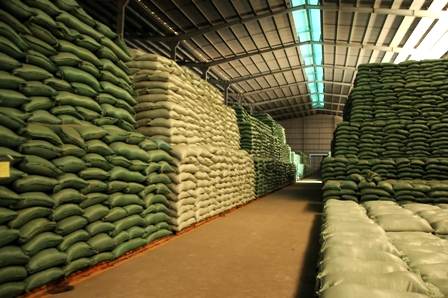Technical Requirements for Mechanized Warehouses Used for Storing Rice
Recently, the Minister of Agriculture and Rural Development has signed and issued Circular 12/2013/TT-BNNPTNT stipulating the National Technical Regulations on Paddy Storage and Paddy Rice Milling Facilities.
Technical Requirements for Equipment and Storage Specifications for Rice in Mechanized Warehouses
The technical requirements for equipment and storage specifications for rice in mechanized warehouses are stipulated in the National Technical Regulation on Rice Storage Warehouses (Designation: QCVN 01 - 133: 2013/BNNPTNT) issued together with Circular 12/2013/TT-BNNPTNT. To be specific:
Illustration (source: internet)
First, regarding general equipment
- Rice dryer: Must have the capability to handle the humidity of rice to meet technical requirements, with drying capacity compatible with the warehouse's storage capacity. Types of dryers include:
+ Tower dryers.
+ Fluidized bed drying systems combined with tower drying.
+ Horizontal dryers.
- Transportation equipment for warehouse loading and unloading.
- Equipment for handling adverse incidents during storage.
- Measurement and monitoring devices for inspecting and supervising technical requirements.
- Lighting system.
Second, technical requirements for equipment and storage specifications for rice in mechanized warehouses
Specific equipment for mechanized warehouses includes:
- The door system must be placed conveniently for transportation and inspections. Windows must have overhangs or louvers to prevent rainwater; natural ventilation doors should have two layers, an inner layer with mesh to keep out birds and rodents and an outer layer of glass or louver, easily opened and closed.
- Loading, unloading, and transportation equipment (including conveyors, bucket elevators, screw conveyors, chain conveyors, vacuums, lifts) must have a capacity suitable for the loading and unloading capacity of the storage warehouse.
- Anti-humidity pallets.
- Equipment for handling adverse incidents during storage includes forced ventilation systems (adequate capacity, ensuring ventilation, dust, and moisture control within the warehouse, meeting technical requirements for rice storage); fumigation equipment (or fumigation measures for product batches when necessary).
- Lighting system within the warehouse (including electric lights and natural light from windows) must ensure adequate illumination. Light fixtures must be safely shielded to prevent breakage and ensure any debris does not fall into the stored products in case of a light breakage.
- Measurement and monitoring devices include: thermometers, hygrometers; weighing systems for warehouse loading and unloading; and quality analysis and inspection equipment for rice.
Storage specifications for rice in mechanized warehouses
- For bulk rice storage: Maximum height of the grain mass is 3.5 meters. The mass of each segment should not exceed 500 tons.
- For bagged rice storage: Bags of rice (50 kg/bag) should be neatly stacked into units with each unit weighing 100 to 250 tons. Every 6 or 7 layers of bags should be recessed by 0.3 meters to form a step. Within each layer, the bags should be interlocked to ensure stability. (For bagged rice with a weight greater than 50 kg/bag, the stacking method must ensure stability and the unit weight should be 100 to 250 tons).
- Ensure minimum distances: Between the rice mass and the warehouse wall is 0.5 meters, between the top of the rice mass and the warehouse roof (or ceiling) is 1.5 meters, and between rice stacks is 1 meter.
For further details, see Circular 12/2013/TT-BNNPTNT effective from August 6, 2013.
Thu Ba
- Number of deputy directors of departments in Vietnam in accordance with Decree 45/2025/ND-CP
- Cases ineligible for pardon in Vietnam in 2025
- Decree 50/2025 amending Decree 151/2017 on the management of public assets in Vietnam
- Circular 07/2025 amending Circular 02/2022 on the Law on Environmental Protection in Vietnam
- Adjustment to the organizational structure of the Ministry of Health of Vietnam: Certain agencies are no longer listed in the organizational structure
- Vietnam aims to welcome 22-23 million international tourists in Vietnam in 2025
-

- Notable new policies of Vietnam effective as of ...
- 16:26, 11/04/2025
-
.Medium.png)
- Notable documents of Vietnam in the previous week ...
- 16:21, 11/04/2025
-
.Medium.png)
- Notable documents of Vietnam in the previous week ...
- 16:11, 02/04/2025
-
.Medium.png)
- Notable new policies of Vietnam to be effective ...
- 16:04, 02/04/2025
-
.Medium.png)
- Notable new policies of Vietnam effective from ...
- 14:51, 21/03/2025
 Article table of contents
Article table of contents

